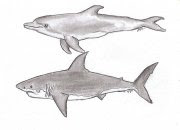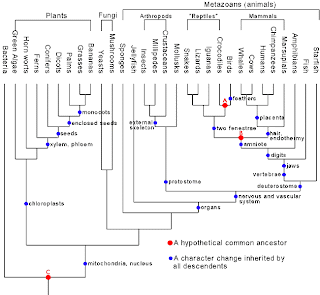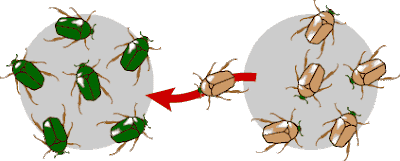Analogous structure: Body parts that once differed in evolutionarily distant lineages but converged in structure and function as responses to similar environmental pressures.
Asteroid: Rocky, metallic body, a few to 1,000 kilometers across, hurtling through space.
Comparative Morphology: Scientific study of comparable body parts of adults or embryonic stages of major lineages.
Derived trait: Trait that evolved once and is shared only by the descendants of the ancestral species in which it evolved.
Fossil: Recognizable, physical evidence of an organism that lived in the distant past.
Fossilization: How fossils form.
Geologic Time Scale: Time scale for the Earth's history with major subdivisions corresponding to mass extinctions.
Gondwana: Paleozoic supercontinent; with other land masses, it formed Pangea.
Half-life: The time it takes for half of a given quantity of any radioisotope to decay into a different, and less unstable, daughter isotope.
Homologous Structure: Comparable body parts in separate lineages that show underlying similarity even when they may differ in size, shape, or function.
Lineage: Line of descent.
Morphological Convergence: Macroevolutionary pattern. In response to similar environmental pressures over time, evolutionarily distant lineages evolve in similar ways and end up being alike in appearance, functions, or both.
Morphological Divergence: Macroevolutionary pattern; genetically diverging lineages undergo change from body form of a common ancestor.
Pangea: Paleozoic supercontinent upon which the first terrestrial plants and animals evolved.
Plate Tectonics Theory: Theory that great plates of the Earth's outer layer float on a hot, plastic mantle. All plates are slowly moving and have rafted continents to new positions over time.
Stratification: Stacked layers of sedimentary rock, built up by gradual deposition of volcanic ash, silt, and other materials over time.

Adaptive Radiation: Macroevolutionary pattern; burst of genetic divergences from a lineage that gives rise to many species, each using a novel resource or a new (or newly vacated) habitat.
Adaptive Zone: Minimum amount of energy required to get a specific reaction going, with or without the help of an enzyme. Reactions differ in the amount required.
Adaptive Zone: Minimum amount of energy required to get a specific reaction going, with or without the help of an enzyme. Reactions differ in the amount required.
Allopatric speciation: Speciation model. A physical barrier arises, separates populations or subpopulations of a species, ends gene flow, and favors divergences that end in speciation.
Anagenesis: Speciation pattern; changes in allele frequencies and morphology accumulate within an unbranched line of descent.
Cladogenesis: Speciation pattern in which a lineage splits and isolated populations undergo genetic divergence.
Cladogenesis: Speciation pattern in which a lineage splits and isolated populations undergo genetic divergence.
Biological Species Concept: Defines a species as one or more populations of individuals that are interbreeding under natural conditions, producing fertile offspring, and are isolated reproductively from other such populations. Applies to sexually reproducing species only.
Dosage Compensation: Any mechanism that balances gene expression between the sexes during critical early stages of development.
Evolutionary Tree: a branch point means divergence from a shared ancestor and branches signify separate lines of descent.
Extinction: Irrevocable loss of a species.
Gene Flow: Microevolutionary process; alleles enter and leave a population as an outcome of immigration and emigration, respectively.
Genetic Divergence: Accumulation of differences in gene pools of populations or subpopulations of a species after a geographic barrier arises and separates them; then, microevolution occurs independently in each.
Evolutionary Tree: a branch point means divergence from a shared ancestor and branches signify separate lines of descent.
Extinction: Irrevocable loss of a species.
Gene Flow: Microevolutionary process; alleles enter and leave a population as an outcome of immigration and emigration, respectively.
Genetic Divergence: Accumulation of differences in gene pools of populations or subpopulations of a species after a geographic barrier arises and separates them; then, microevolution occurs independently in each.
Gradual model of speciation: Idea that species arise by many small morphological changes that accumulate over great spans of time.
Punctuation model of speciation: Idea that most morphological changes occur in a brief span when populations start to diverge; speciation is rapid, and the daughter species change little or the next 2-6 million years or so.
Hybrid zone: Where adjoining populations are interbreeding and producing hybrid offspring.
Punctuation model of speciation: Idea that most morphological changes occur in a brief span when populations start to diverge; speciation is rapid, and the daughter species change little or the next 2-6 million years or so.
Hybrid zone: Where adjoining populations are interbreeding and producing hybrid offspring.
Mass Extinction: Catastrophic event or phase in geologic time when entire families or other major groups are irrevocably lost.
Parapatric Speciation: Idea that neighboring populations can become distinct species while maintaining contact along a common border.
Reproductive Isolating Mechanism: Heritable feature of body form, functioning, or behavior that prevents interbreeding between two or more genetically divergent populations.
Speciation: The formation of a daughter species from a population or subpopulation of a parent species by way of microevolutionary processes. Routes vary in their details and duration.
Species: One kind of organism. Of sexually reproducing organisms, one or more natural populations in which individuals are interbreeding and are reproductively isolated from other such groups.
Species: One kind of organism. Of sexually reproducing organisms, one or more natural populations in which individuals are interbreeding and are reproductively isolated from other such groups.
Sympatric Speciation: A speciation event within the home range of an existing species, in the 1absence of a physical barrier. Such species may form instantaneously, as by polyploidy.



































No hay comentarios:
Publicar un comentario